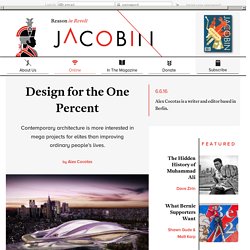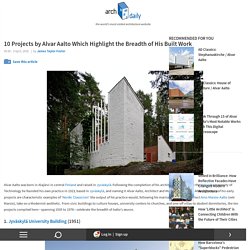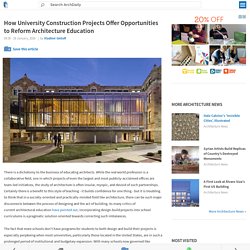

Primo ARCHI. Tout est paysage, une architecture habitée - Simone et Lucien Kroll. The Importance of The Sketch in Renzo Piano's Work. Lucien kroll. Fernando tavora vila da feira. Design for the One Percent. Our new issue, “Between the Risings,” is out now.

To celebrate its release, international subscriptions are $25 off, and limited prints of our Easter 1916 cover are available. Zaha Hadid, a pioneering architect and the first female recipient of the Pritzker Prize, died in March at the age of sixty-five. Her vision and ambition have been rightfully celebrated around the world in the weeks since. But her passing also offers a moment to reflect critically on the state of contemporary architecture.
Not so long ago, the world’s leading architects debated how architecture could be used to transform society by providing housing for workers, improving public health, and fostering social solidarity. Some of the starchitects’ projects are beautiful, to be sure. Many architectural creations are poorly constructed, requiring exorbitant maintenance costs (invariably following massive budget overruns) and lacking consideration for the people who actually live in the built environment. The Starchitects. Norman Foster on the Boeing 747 "Jumbo Jet" In an article for Reading Design, Norman Foster—a passionate aeronaut—describes how the groundbreaking design of the Boeing 747 "Jumbo Jet," the iconic airplane envisioned by engineer Joseph "Joe" Sutter in the 1960s, remains timeless.

Likening both its method of construction and means of operation to that of a typical building, Foster asserts that it speaks of "the international hotel style," which he supposes as appropriate: "people come and go, it does not have a great deal of character and it could be almost anywhere. " There is, I believe, a common misconception about architecture and design – the belief that if the forces of nature are allowed to create form then that form will be automatically beautiful (the "if it looks right it is right" sort of argument). Personally, I think this is nonsense. Rem Koolhaas Asks: Are Smart Cities Condemned to Be Stupid?
Originally published by the European Commission as part of their "Digital Minds for a New Europe" series, this article is an edited transcript of a talk given by Rem Koolhaas at the High Level Group meeting on Smart Cities, Brussels, 24 September 2014.

I had a sinking feeling as I was listening to the talks by these prominent figures in the field of smart cities because the city used to be the domain of the architect, and now, frankly, they have made it their domain. This transfer of authority has been achieved in a clever way by calling their city smart – and by calling it smart, our city is condemned to being stupid. Here are some thoughts on the smart city, some of which are critical; but in the end, it is clear that those in the digital realm and architects will have to work together. Architecture used to be about the creation of community, and making the best effort at symbolizing that community.
The car is a key element in the smart city. 10 Projects by Alvar Aalto Which Highlight the Breadth of His Built Work. 10 Projects by Alvar Aalto Which Highlight the Breadth of His Built Work Alvar Aalto was born in Alajärvi in central Finland and raised in Jyväskylä.

Following the completion of his architectural studies at the Helsinki University of Technology he founded his own practice in 1923, based in Jyväskylä, and naming it Alvar Aalto, Architect and Monumental Artist. Although many of his early projects are characteristic examples of 'Nordic Classicism' the output of his practice would, following his marriage to fellow Architect Aino Marsio-Aalto (née Marsio), take on a Modernist aesthetic. From civic buildings to culture houses, university centers to churches, and one-off villas to student dormitories, the ten projects compiled here—spanning 1935 to 1978—celebrate the breadth of Aalto's œuvre. 1. 2. 3. 4. 5.
« La périphérie est abandonnée par les dieux de l’architecture » Musicarmonia.fr - David Chipperfield architecte de l'équilibre. David Chipperfield architecte de l'équilibre Détails.

20 Things You Didn't Know About Mies van der Rohe. 20 Things You Didn't Know About Mies van der Rohe Today marks 130 years since the birth of German architect Ludwig Mies van der Rohe.

In honor of this tremendously influential figure, we're shining some light into the lesser known facts about Mies' life in order to better understand and contextualize his architecture. For this, our colleagues at ArchDaily en Español have referred to "Vidas construidas, Biografías de arquitectos" (Constructed Lives, Biographies of Architects), a book by Anatxu Zabalbeascoa and Javier Rodríguez Marcos. This text, released by publisher Gustavo Gili, features the biographies of 20 of the world's most celebrated architects, from the Renaissance to the Modern movement.
Each story is a fascinating journey into the lives of each architect, and the details allow us to understand the genesis of many works that are today considered classics. 1. Gallery of Archi-Graphic: An Infographic Look at Architecture - 8. How University Construction Projects Offer Opportunities to Reform Architecture Education. There is a dichotomy to the business of educating architects.

While the real world profession is a collaborative field, one in which projects of even the largest and most publicly-acclaimed offices are team-led initiatives, the study of architecture is often insular, myopic, and devoid of such partnerships. Certainly there is a benefit to this style of teaching - it builds confidence for one thing - but it is troubling to think that in a socially-oriented and practically-minded field like architecture, there can be such major disconnects between the process of designing and the act of building.
As many critics of current architectural education have pointed out, incorporating design-build projects into school curriculums is a pragmatic solution oriented towards correcting such imbalances. James stirling. 50 Things You Didn't Know About Le Corbusier. You know him for his round glasses, affinity for concrete and undying love for modernism, but do you really know Le Corbusier?

Le Corbusier led his life not just as the 20th century's most influential architect, but also as an artist, socialite and theoretician. Taught by architects August Perret and Peter Behrens, criticized by the likes of Jane Jacobs and celebrated worldwide, Le Corbusier's legacy is undeniable. Dabbling often with controversy, Le Corbusier preferred the mantra “Architecture or Revolution,” designing structures that have been dubbed "anti-humanist.
" While some propose that his buildings collectively become a UNESCO World Heritage site, many call for their demolition. In 2015, 50 years after his death, the debate on the calibre of his controversial projects rages on. 1. 2. 3. 4. 5. 6. 7. 8. Les projets d'André Ravéreau. Edouard François: Les Lanternes. « Les Lanternes » est un projet prospectif pour le Moyen-Orient.

Les Lanternes forment des émergences transparentes, éclairant la nuit et offrant l'opportunité d'habiter différemment. Chaque Lanterne abrite les parties les plus luxueuses du projet et repose sur un principe simple : des parties communes en toiture, telle une piscine avec bar, des extensions pour les appartements situés en bas, ainsi que des terrasses de grandes tailles, des sortes de salon d’été.
Ces salons sont habités derrière des moucharabiehs contemporains en métal noble découpé au laser, s’ouvrant et se fermant au gré du soleil. Les Lanternes sont littéralement hors d’échelle pour n’être qu’abstraites et contemporaines. Des salons d’été indépendants permettent aux habitants situés dans les parties basses, de profiter du soleil et de bénéficier également d’une vue dégagée sur les horizons orientaux. PROGRAMME Projet résidentiel, immeubles collectifs et commerces SURFACE N.C BUDGET N.C Calendrier N.C.
EXPOSITION CONFERENCE - septembre 2011 - la laverie lieu de cultures. Les expositions organisées par La Laverie cherchent à aborder l'architecture sous tous ces angles et diffuser au plus grand nombre ces regards particuliers d'architectes, d'historiens et de chercheurs. Au début des années 1990 la ville de Tours s’interroge quant au devenir de son Centre de Création Contemporaine, alors situé dans les locaux du Lycée Paul Louis Courrier, et qui ne cesse de se développer depuis une douzaine d’années. Sa forte croissance lui vaut la mise en place d’un partenariat avec le Ministère de la Culture en 1993, mobilisant d’importants crédits en vue de fédérer un véritable et rayonnant Centre de la Création Contemporaine.
Une grande étude de faisabilité et de programmation est lancée sur le site Francis Poulenc (les jardins du Conservatoire), sous la direction de la société Art Public Contemporain. Le programme annonce la réalisation d’un ensemble architectural comprenant le nouveau CCC et le Théâtre de la rue Léonard de Vinci, devenu inadapté. Thèse: archi non standard. Cyber@rchitecture. Machine athmosphérique. Architecture numérique. Conception Générative. Stratégie logicielle. Processing.org. Processing -Ecole d’Art d’Aix en provence. Ce cours de programmation remplace celui sur Director.

Il est basé sur un projet collectif riche, ouverte (open source) et grauite, conçu entre le M.I.T. Rhinoceros. Objectile (agence) Asymptote - Archilab 1999 français. Archigram Archival Project. Rem Koolhaas on OMA/Progress at the Barbican: 'I'm a criticism machine' - video. Génie Réactionnaire. Postmodernité.